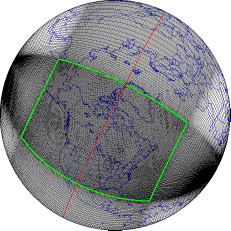Quoted from: https://collaboration.cmc.ec.gc.ca/science/rpn/gef_html_public/INTRODUCTION/gem_intro.html
An integrated forecasting and data assimilation system has been developed with a view to meeting all of the current and foreseeable operational weather-forecasting needs of Canada for the coming years. The model's name GEM stands for Global Environmental Multiscale model.
THE VARIABLE-RESOLUTION STRATEGY
The model is global so that the long waves are handled properly for both data assimilation and extended-range forecasting. The model has a variable-resolution capability such that it is possible to use either a uniform-resolution latitude/longitude mesh, or a variable-resolution one that uses a rotated-coordinate system with a high-resolution sub-domain that can be located over any portion of the globe. Outside this area, the grid spacing smoothly increases to reach its maximum value at the antipodes.
NUMERICAL TECHNIQUES
- Horizontal variable-resolution cell-integrated finite-element discretization reducing to the usual staggered finite differences discretization at uniform resolution in spherical geometry.
- Semi-implicit semi-Lagrangian time discretization scheme which removes the overly- restrictive time step limitation imposed by the use of a more conventional Eulerian scheme.
- Hydrostatic-pressure-type hybrid vertical coordinate.
OPERATIONAL APPLICATION
A uniform- and moderate-resolution configuration of the model drives a data assimilation cycle that provides an objective analysis. Medium- and extended-range forecasts are then initiated from this analysis. A regional analysis/forecast cycle, run in parallel, is driven by a variable- resolution configuration of the same model having its region of interest at the continental scale centered over Canada with a resolution of about three times that used by the longer-range weather forecast version. The regional cycle is regularly "spun-up" from the main analysis cycle to prevent the errors (or the "model's climatology") associated with the low-resolution portion of the grid from reaching and contaminating the analysis over the region of interest.
Both of these applications are made within a single dynamical framework. For the development of a data assimilation system, the effort needed to develop the tangent linear model and its adjoint is reduced significantly by this choice of strategy. The same can be said of the improvement of the model's physical parameterization. The strategy results in the maintenance of only one set of libraries and procedures.
In summary, all the previously described needs are taken into account by a data assimilation and forecast system at the heart of which lies a single multipurpose and multiscale numerical model, thus minimizing the development and maintenance cost.
FUTURE DEVELOPMENT
Development projects include:
- The completion of a 4D variational data-assimilation system;
- The completion of a non-hydrostatic version;
- Vertical extension of the model for stratospheric modeling and data assimilation;
- The development of spectral and limited-area versions of the model.








